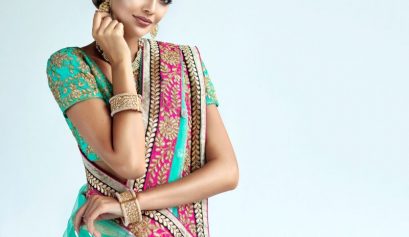The Indian saree is more than just a piece of clothing; it is a symbol of elegance, tradition, and cultural heritage. This timeless garment has adorned women across India for centuries, and its appeal endures in contemporary fashion. The saree, with its rich history and versatile nature, represents a blend of tradition and modernity, making it a cherished attire for women of all ages.
A Brief History of the Saree
The saree is one of the oldest garments in the world, with a history that dates back over 5,000 years. Its origins can be traced to ancient India, where it was worn by women as a draped garment, often paired with a blouse and petticoat. The word “saree” is derived from the Sanskrit term “sati,” which means “strip of cloth.”
Historically, the saree was worn in various styles across different regions of India, each reflecting local customs and traditions. Over time, the saree evolved into numerous regional variations, incorporating diverse fabrics, weaves, and embellishments. Despite these regional differences, the saree has always remained a symbol of grace and femininity.
The Versatility of the Saree
One of the most remarkable aspects of the saree is its versatility. Unlike many Western garments, the saree can be draped in multiple styles, each offering a unique look and feel. The most common drape is the Nivi style, which involves tucking the saree into the waistband and draping it over the shoulder, creating a classic and elegant silhouette. Other styles, such as the Bengali, Maharashtrian, and Gujarati drapes, reflect the diverse cultural heritage of India.
The saree is also versatile in terms of fabric and design. It can be made from a wide range of materials, including silk, cotton, chiffon, georgette, and crepe. Each fabric offers different draping qualities and comfort levels, making the saree suitable for various occasions. For instance, silk sarees are often chosen for formal events and weddings due to their luxurious texture and intricate embroidery, while cotton sarees are favored for everyday wear because of their comfort and breathability.
Sarees for Different Occasions
The saree’s adaptability makes it appropriate for a variety of occasions, from everyday wear to grand celebrations. Here’s how sarees cater to different events:
- Casual Wear: For everyday wear, simple cotton or linen sarees are ideal. They offer comfort and ease while still maintaining a touch of traditional charm. These sarees often feature minimal embellishments and are easy to drape, making them perfect for routine activities or casual gatherings.
- Festive and Cultural Events: During festivals and cultural celebrations, sarees in vibrant colors and rich fabrics come into play. Traditional sarees adorned with embroidery, mirror work, or block prints are popular choices for events like Diwali, Eid, and regional festivals. These sarees often showcase intricate craftsmanship and reflect the celebratory spirit of the occasion.
- Formal and Bridal Wear: For formal occasions, such as weddings or formal dinners, silk sarees with elaborate designs and heavy embellishments are preferred. Bridal sarees, in particular, are a highlight of Indian weddings. They are often made from luxurious fabrics like Banarasi silk or Kanjivaram silk and are richly decorated with zari (gold or silver thread) work, making them a centerpiece of the bridal ensemble.
- Office and Professional Settings: Sarees are also a popular choice for professional settings. Elegant yet understated designs in fabrics like crepe or georgette are suitable for office wear. These sarees typically feature simple patterns and minimal embellishments, ensuring a professional and polished appearance.
Regional Variations and Their Unique Features
India’s diverse cultural landscape is reflected in the numerous regional styles of sarees. Each region has its own distinctive saree tradition, characterized by unique weaving techniques, fabrics, and motifs:
- Banarasi Sarees: Originating from Varanasi, these sarees are known for their opulent silk and intricate zari work. They are often chosen for weddings and ceremonial occasions due to their luxurious appearance and craftsmanship.
- Kanjivaram Sarees: Hailing from Tamil Nadu, Kanjivaram sarees are famous for their vibrant colors and rich silk. They feature elaborate designs and contrasting borders, making them a popular choice for bridal wear.
- Sarees from Gujarat: Gujarat is known for its colorful and embroidered sarees, such as the Bandhani and Patola. Bandhani sarees feature tie-dye patterns, while Patola sarees are known for their intricate weaving and geometric designs.
- Mysore Silk Sarees: Mysore silk sarees from Karnataka are celebrated for their smooth texture and subtle sheen. They often feature elegant patterns and are favored for their understated elegance.
- Sarees from Bengal: Bengali sarees, including the Tant and Jamdani, are known for their lightweight fabric and intricate handwoven designs. They often feature traditional motifs and are appreciated for their comfort and grace.
The Saree in Contemporary Fashion
In recent years, the saree has undergone a transformation in contemporary fashion. Designers are experimenting with modern interpretations of the saree, incorporating contemporary fabrics, innovative draping styles, and fusion elements. The saree has been reimagined for fashion shows, celebrity events, and international platforms, showcasing its timeless appeal and versatility.
Modern variations include pre-draped sarees, saree gowns, and saree skirts, which blend traditional elements with contemporary aesthetics. These adaptations make the saree more accessible and versatile, catering to the tastes and preferences of a new generation of fashion enthusiasts.
Conclusion
The Indian saree is a cherished garment that embodies the rich cultural heritage and fashion sensibilities of India. Its versatility, adaptability, and timeless appeal make it a versatile choice for a wide range of occasions. Whether adorned with intricate embroidery or styled with a modern twist, the saree continues to be a symbol of grace and elegance, bridging the gap between tradition and contemporary fashion. For women who appreciate both style and heritage, the saree remains an enduring and cherished fashion choice.
